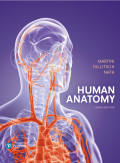
Match each numbered item with the most closely related lettered item.
ventral root …………………………...
To review:
Match the term ventral root with the most closely related description given below:
Tracts and columns
Specific region of body surface
Cervical plexus
Motor neuron axons
Sacral plexus
Lumbar plexus
Single bundle of axons
Involuntary motor response
Loose connective tissue, adipose tissue
Pectoral girdle/upper extremity
Introduction:
Spinal cord and brain are a part of the central nervous system (CNS). The spinal cord is divided into 31 sections, each of the sections are having a pair of dorsal and ventral roots; and dorsal root ganglia. When the motor neuron is activated, the action potential travels via the ventral root to the effector organs.
Explanation of Solution
The ventral root is also known as the anterior root. It is able to control the peripheral effectors via the visceral motor neurons. The ventral root consists of the axons of motor neurons. A dorsal and ventral root combines to give rise to the spinal nerve that goes through the intervertebral opening. The ventral roots are thinner than the dorsal roots.
Therefore, it can be concluded that the term ventral root can be correctly matched with option (d) motor neuron axons.
Want to see more full solutions like this?
Chapter 14 Solutions
EBK HUMAN ANATOMY
- Describe the origin and early evolution ofmammals.arrow_forwardDraw the structure of hypogynous and perigynous and epigynous?arrow_forwardThe deep inguinal ring is formed from which of the following? (A) transversalis fascia (B) peritoneum (C) connective tissue of the transversus abdominus muscle (D) connective tissue of the internal abdominal oblique (E) connective tissue of the external abdominal obliquearrow_forward
- Histology is the same as (a) pathological anatomy, (b) ultrastructure, (c) functional morphology, (d) surface anatomy, (e) microscopic anatomy.arrow_forwardTendons attach muscles to bones. Tendons are extensions of the: a)epimysium. b)perimysium. c) endomysium. d) fascia.arrow_forwardThe ventral surface of the body is the same as its_____ surface.(a) medial, (b) superior, (c) superficial, (d) anterior, (e) distal.arrow_forward
- Identify the organ system that each group of organs listed here is part of:(a) thymus, thyroid, ovary, pancreas(b) nasal cavity, larynx, bronchi, lungs(c) kidney, ureter, urethraarrow_forwardUsing the terms listed below, fill in the blank with the proper term. anterior superior medial proximal superficial posterior inferior lateral distal deep(a) The heart is located______ to the diaphragm.(b) The muscles are_____ to the skin.(c) The shoulder is_____ to the elbow.(d) In anatomical position, the thumb is_____ to the index finger.(e) The vertebral region is_____ to the scapular region.(f) The nose is_____ to the chin.(g) The toes are_____ to the heel.arrow_forwardWhat are the various OGD's and their functions?arrow_forward
 Human Anatomy & Physiology (11th Edition)BiologyISBN:9780134580999Author:Elaine N. Marieb, Katja N. HoehnPublisher:PEARSON
Human Anatomy & Physiology (11th Edition)BiologyISBN:9780134580999Author:Elaine N. Marieb, Katja N. HoehnPublisher:PEARSON Biology 2eBiologyISBN:9781947172517Author:Matthew Douglas, Jung Choi, Mary Ann ClarkPublisher:OpenStax
Biology 2eBiologyISBN:9781947172517Author:Matthew Douglas, Jung Choi, Mary Ann ClarkPublisher:OpenStax Anatomy & PhysiologyBiologyISBN:9781259398629Author:McKinley, Michael P., O'loughlin, Valerie Dean, Bidle, Theresa StouterPublisher:Mcgraw Hill Education,
Anatomy & PhysiologyBiologyISBN:9781259398629Author:McKinley, Michael P., O'loughlin, Valerie Dean, Bidle, Theresa StouterPublisher:Mcgraw Hill Education, Molecular Biology of the Cell (Sixth Edition)BiologyISBN:9780815344322Author:Bruce Alberts, Alexander D. Johnson, Julian Lewis, David Morgan, Martin Raff, Keith Roberts, Peter WalterPublisher:W. W. Norton & Company
Molecular Biology of the Cell (Sixth Edition)BiologyISBN:9780815344322Author:Bruce Alberts, Alexander D. Johnson, Julian Lewis, David Morgan, Martin Raff, Keith Roberts, Peter WalterPublisher:W. W. Norton & Company Laboratory Manual For Human Anatomy & PhysiologyBiologyISBN:9781260159363Author:Martin, Terry R., Prentice-craver, CynthiaPublisher:McGraw-Hill Publishing Co.
Laboratory Manual For Human Anatomy & PhysiologyBiologyISBN:9781260159363Author:Martin, Terry R., Prentice-craver, CynthiaPublisher:McGraw-Hill Publishing Co. Inquiry Into Life (16th Edition)BiologyISBN:9781260231700Author:Sylvia S. Mader, Michael WindelspechtPublisher:McGraw Hill Education
Inquiry Into Life (16th Edition)BiologyISBN:9781260231700Author:Sylvia S. Mader, Michael WindelspechtPublisher:McGraw Hill Education





